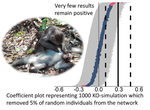
WEBBER Quinn
- recommender
Recommendations: 0
Review: 1
Review: 1

Linking parasitism to network centrality and the impact of sampling bias in its interpretation
Centrality and parasite loads in sampled networks
Recommended by Matthew Silk based on reviews by Krishna Balasubramaniam, Quinn Webber and 1 anonymous reviewerNetworks provide an ideal tool to link social behaviour and infection in animal societies (White et al. 2017). A major focus of previous research has been on the links between social centrality and infection (Briard & Ezenwa 2021). But what happens when conclusions are drawn from sampled networks in which some individuals are not observed, or when studies focus on some individuals at the expense of others (e.g. adults versus juveniles or females versus males)? Xu et al. (2022) examine how focusing on different samples of individuals in a network analysis relating centrality to parasite load in Japanese macaques Macaca fuscata influence the conclusions drawn.
Xu et al. (2022) use faecal egg counts to estimate parasite loads of three environmentally transmitted parasites Oesophagostomum aculeatum, Strongyloides fuelleborni and Trichuris trichiura in a group of macaques on Koshima Island, Japan. After showing positive associations between parasite load and strength (the sum of an individual’s connections) and eigenvector centrality (accounting for second-order connections) in a 1-metre proximity network, the authors explore how this result is impacted by focusing on only adult females, only juveniles or random sub-samples of the population. Their results indicate that the positive association persists more strongly in the adult female networks albeit with reduced statistical power to detect it. It is largely absent in juveniles (either based on their centrality in the full network or centrality in the juvenile-only network). Random removal of individuals from the network led to a rapid reduction in the ability to detect the same positive association between centrality and parasite load due to a combination of changes in individual centrality in re-sampled networks and reduced statistical power.
The timescale of network data collection and proximity networks studied are (likely) not fully relevant for the transmission of these parasites and social transmission of the parasites studied here is likely to be limited, there remain other reasons that we may expect correlations between sociality and infection (Ezenwa et al. 2016). Nevertheless, this is a useful contribution to the literature on sampling effects in animal networks, complementing existing work (Franks et al. 2010, Silk et al. 2015, Davis et al. 2018, Silk 2018). The results from considering different sub-samples of the group show the potential importance of carefully considering whether social network effects will be equivalently important for the whole population and which interactions will contribute either to promoting health or increasing the risk of infection. The results of random sub-sampling show how in small (within-group) networks such as these even small numbers of missing individuals could have substantial impacts on testing how traits are associated with the social network position of individuals.
The findings set up some interesting questions about how best to develop effective sampling designs in single-group studies such as these, or in how best to extend these types of projects across multiple groups (see also Silk 2018). Testing the generality of these findings across taxa with different social systems and infection prevalences or loads will also be a valuable next step for behavioural disease ecology.
References
Briard L, Ezenwa VO. 2021. Parasitism and host social behaviour: a meta-analysis of insights derived from social network analysis. Anim. Behav. 172, 171-182. https://doi.org/10.1016/j.anbehav.2020.11.010
Davis GH, Crofoot MC, Farine DR. 2018. Estimating the robustness and uncertainty of animal social networks using different observational methods. Anim. Behav. 141, 29-44. https://doi.org/10.1016/j.anbehav.2018.04.012
Ezenwa VO, Ghai RR, McKay AF, Williams AE. 2016. Group living and pathogen infection revisited. Curr. Opin. Behav. Sci. 12, 66-72. https://doi.org/10.1016/j.cobeha.2016.09.006
Franks DW, Ruxton GD, James R. 2010. Sampling animal association networks with the gambit of the group. Behav. Ecol. Sociobiol. 64, 493-503. https://doi.org/10.1007/s00265-009-0865-8
Silk MJ, Jackson AL, Croft DP, Colhoun K, Bearhop S. 2015. The consequences of unidentifiable individuals for the analysis of an animal social network. Anim. Behav. 104, 1-11. https://doi.org/10.1016/j.anbehav.2015.03.005
Silk MJ. 2018. The next steps in the study of missing individuals in networks: a comment on Smith et al. (2017). Soc. Net. 52, 37-41. https://doi.org/10.1016/j.socnet.2017.05.002
White LA, Forester JD, Craft ME. 2017. Using contact networks to explore mechanisms of parasite transmission in wildlife. Biol. Rev. 92, 389-409. https://doi.org/10.1111/brv.12236
Xu Z, MacIntosh AJJ, Castellano-Navarro A, Macanás-Martinez E, Suzumura T, Dubosq J. 2022. Linking parasitism to network centrality and the impact of sampling bias in its interpretation. bioRxiv 2021.06.07.447302, ver. 6 peer-reviewed and recommended by Peer Community in Network Science. https://doi.org/10.1101/2021.06.07.447302